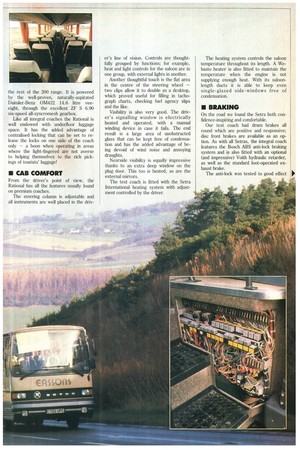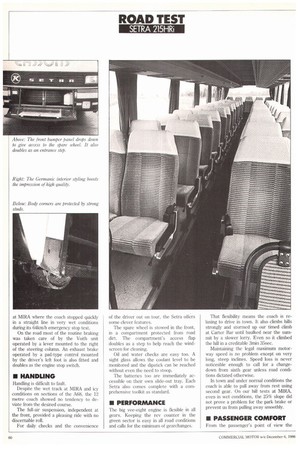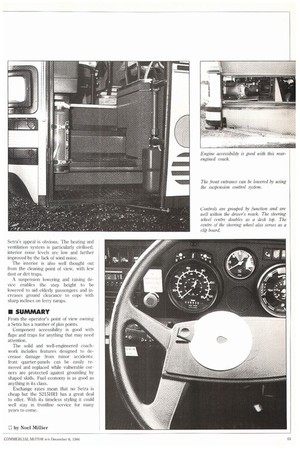PERFECTLY RATIONAL
Page 70

Page 71

Page 72

Page 73

If you've noticed an error in this article please click here to report it so we can fix it.
To find out how Setra's renowned high standard of finish is maintained at the bottom of its range CM has been out and about in a base model 521 5HRI Rational.
• Setra Coaches are regarded by many as the Rolls-Royces of the luxury coach world.
A Setra's quality of finish may well be unsurpassed — but does it justify its premium price with a sensible return?
To find out CM has just tested Setra's S215HR1 Rational on our Scottish test route and found this 'base' model to be far from basic.
The test coach has been in service with Southampton-based Eassons since April and has covered some 40,000km in normal coach operation. It is a 12-metre 53-seater with, by Setra standards, a minimum of extras although by any normal standards it is well equipped.
Everything about the Setra seems well thought out. Access to virtually all mechanical and body components, including the electrical and heating systems, is easy. Even the windscreen wiper motor can be reached in a matter of moments by removing a push-fit cover. Once main
tenance is completed there is no awkward trim to replace as everything has a purpose-designed cover.
The Rational is not the best-looking Setra available. It lacks the striking angled windscreen of its more expensive stablemates and looks more like a run-ofthe-mill vehicle.
Once inside, however, its conventional shape in no way detracts from either driver or passenger appeal.
Mechanically the Rational is similar to the rest of the 200 range. It is powered by the well-proven, naturally-aspirated Daimler-Benz 0114422. 14.6 litre veeeight, through the excellent ZF S 6.90 six-speed all-syncromesh gearbox.
Like all integral coaches the Rational is well endowed with underfloor luggage space. It has the added advantage of centralised locking that can be set to release the locks on one side of the coach only — a boon when operating in areas where the light-fingered are not averse to helping themselves to the rich pickings of tourists' luggage!
• CAB COMFORT
From the driver's point of view, the Rational has all the features usually found on premium coaches.
The steering column is adjustable and all instruments are well placed in the driv er's line of vision. Controls are thoughtfully grouped by functions; for example, heat and light controls for the saloon are in one group, with external tights in another.
Another thoughtful touch is the flat area in the centre of the steering wheel — two clips allow it to double as a desktop, which proved useful for filling in tachograph charts, checking fuel agency slips and the like.
Visibility is also very good. The driver's signalling window is electrically heated and operated, with a manual winding device in case it fails. The end result is a large area of unobstructed glass that can be kept free of condensation and has the added advantage of being devoid of wind noise and annoying draughts.
Nearside visibility is equally impressive thanks to an extra deep window on the plug door. This too is heated, as are the external mirrors.
The test coach is fitted with the Setra International heating system with adjustment controlled by the driver. The heating system controls the saloon temperature throughout its length. A Webasto heater is also fitted to maintain the temperature when the engine is not supplying enough heat. With its saloonlength ducts it is able to keep even single-glazed side-windows free of condensation.
II BRAKING
On the road we found the Setra both confidence-inspiring and comfortable.
Our test coach had drum brakes all round which are positive and responsive; disc front brakes are available as an option. As with all Setras, the integral coach features the Bosch ABS anti-lock braking system and is also fitted with an optional (and impressive) Voith hydraulic retarder, as well as the standard foot-operated exhaust brake.
The anti-lock was tested to good effect at MIRA where the coach stopped quickly in a straight line in very wet conditions during its 64km/h emergency stop test.
On the road most of the routine braking was taken care of by the Voith unit operated by a lever mounted to the right of the steering column. An exhaust brake operated by a pad-type control mounted by the driver's left foot is also fitted and doubles as the engine stop switch.
• HANDLING
Handling is difficult to fault.
Despite the wet track at MIRA and icy conditions on sections of the A68, the 12 metre coach showed no tendency to deviate from the desired course.
The full-air suspension, independent at the front, provided a pleasing ride with no discernable roll.
For daily checks and the convenience of the driver out on tour, the Setra offers some clever features.
The spare wheel is stowed in the front, in a compartment protected from road dirt. The compartment's access flap doubles as a step to help reach the windscreen for cleaning.
Oil and water checks are easy too. A sight glass allows the coolant level to be monitored and the dipstick can be reached without even the need to stoop.
The batteries too are immediately accessible on their own slide-out tray. Each Setra also comes complete with a comprehensive toolkit as standard.
• PERFORMANCE
The big vee-eight engine is flexible in all gears. Keeping the rev counter in the green sector is easy in all road conditions and calls for the minimum of gearchanges. That flexibility means the coach is relaxing to drive in town. It also climbs hills strongly and stormed up our timed climb at Carter Bar until baulked near the summit by a slower lorry. Even so it climbed the hill in a creditable 3min 35sec.
Maintaining the legal maximum motorway speed is no problem except on very long, steep inclines. Speed loss is never noticeable enough to call for a changedown from sixth gear unless road conditions dictated otherwise.
In town and under normal conditions the coach is able to pull away from rest using second gear. On our hill tests at MIRA, even in wet conditions, the 25% slope did not prove a problem for the park brake or prevent us from pulling away smoothly.
• PASSENGER COMFORT
From the passenger's point of view the Setra's appeal is obvious. The heating and ventilation system is particularly civilised; interior noise levels are low and further improved by the lack of wind noise.
The interior is also well thought out from the cleaning point of view, with few dust or dirt traps.
A suspension lowering and raising device enables the step height to be lowered to aid elderly passengers and increases ground clearance to cope with sharp inclines on ferry ramps.
• SUMMARY
From the operator's point of view owning a Setra has a number of plus points.
Component accessibility is good with flaps and traps for anything that may need attention.
The solid and well-engineered coachwork includes features designed to decrease damage from minor accidents: front quarter-panels can be easily removed and replaced while vulnerable corners are protected against grounding by shaped skids. Fuel economy is as good as anything in its class.
Exchange rates mean that no Setra is cheap but the S2151-1R1 has a great deal to offer. With its timeless styling it could well stay in frontline service for many years to come.
0 by Noel Millier














































































































